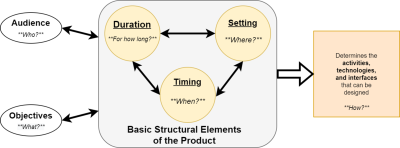Structural considerations of design
From The Learning Engineer's Knowledgebase
The structural considerations of design are core elements that must be decided about a product's structure before the design phase can proceed. The structural elements are so fundamental to the design that they are considered an important part of the initial planning process for making an educational product.
➡️ This wiki provides a step-by-step process on considering and defining the key structural elements of a project to guide the design process.
Definition
The basic structural elements of a product are fundamental to the design and determine when, where, and for how long an audience will interact with the product. These questions are essential to determining what kinds of activities, interactions, technology, and media that can be used in a product. As such, the basic structural elements of a product are often defined early in the analysis phase of a project.
Additional Information

Basic structural elements of an educational product
There are three basic structural elements of an educational product that all designers should consider and define early in the analysis and design processes. These three structural elements are best written down when possible as design specifications.
- Duration. This element determines for how long the product should be used or the experience should typically last.
- Timing. This element defines what the expectations for interactions are among participants (e.g., asynchronous, synchronous, or hybrid).
- Location Setting. This element defines where participants are expected to use the product or participate in activities (e.g., in-person, online, hybrid)
The structural elements of a product are a key component of the scope of a project. Keeping this in mind, it is useful to consider the structural components of a project early when in the analysis phase of the project, as these choices will dramatically influence the kinds of choices that can be made in the design and development phases. It is best to know these things earlier than later to save time, resources, and potentially having to unnecessarily redo work.
When defining the structural elements of a product, the W6H framework is a useful model for how to write design specifications that document the three structural considerations for the design team to follow.
⚠️ It is often wise to consider the learning objectives, audience, and initial constraints of a project in combination with considering the structural elements of a product. These other elements of a project's scope will determine in part the structural elements that are feasible.
➡️ This wiki provides a step-by-step process on considering and defining the key structural elements of a project to guide the design process.
Related Concepts
- Project scope
- Duration of learning experience (scope)
- Timing of learning experience (scope)
- Setting of the learning experience
- Design specifications
- W6H framework for design specifications
Examples
None yet - check back soon!
External Resources
None yet - check back soon!